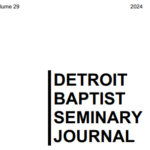Praying the Bible by Donald Whitney
Coming in at exactly 100 small pages, Donald Whitney’s book is deceptive. Under such a small frame hides a powerful message and one that I have been able to see fruitfully applied in different contexts over the last few years.
Around two years ago I was introduced to this book through David Doran Jr. I remember the Wednesday night he introduced the book and then gave us an opportunity to put into practice its method. Over the last few years, our church has sought to apply the method to our public prayers. And just a few nights ago, as my wife and I were praying, she prayed using the method.
What is this method? It is simply using the Bible as the motivation for our prayer. It is probably best to see it worked out in an example. The following is a passage of Scripture (Psalm 23:1–4) followed by a prayer modeled after that passage.
1 The Lord is my shepherd;
I have what I need.
2 He lets me lie down in green pastures;
he leads me beside quiet waters.
3 He renews my life;
he leads me along the right paths
for his name’s sake.
4 Even when I go through the darkest valley,
I fear no danger,
for you are with me;
your rod and your staff—they comfort me.
Father, you are my Lord and my Shepherd. I thank you for your guidance. I thank you that you have many sheep who are not yet in your fold. You will call them and they will hear your voice. This encourages me towards obedience to the Great Commission. I am grateful that you called my name and the name of my wife, and I pray that one day you would call the name of my children. I’m grateful that your path is good, and that you have faithfully provided for our need. O Lord you have indeed made me to lie down in Green Pastures. There are so many good things that you’ve given to me in life –including many that I overlook—but I thank you for them. I thank you for the quiet waters, and yet I know Lord that you allow some dark valleys. When I go through them remind me that you are still my shepherd. I think now of those in our church going through dark valleys, so dark that they cannot see You. They may fear that you are not leading them. Remind them that you are there, even in dark valleys. Remind them that they have no need to fear danger for you are truly with them. Lord use your rod and your staff to comfort us, amen.
As you can see, the method Whitney teaches combines biblical meditation with petition. As I consider what the Bible says, I allow that to guide what I say and ask. Such a method is not designed to replace what you are already doing in prayer, but it can fruitfully supplement it.
Whitney has taught this method of spiritual discipline for decades and he makes a good case for its biblical warrant (shouldn’t we let the Word guide our prayer?). I encourage you to take up and read!
* One criticism that could be leveled against Whitney is that his model appears to overlook proper methods of interpretation. He is less concerned that one interpret the text and then pray it as he is that our prayer is sourced in Scripture. For instance, he positively suggests that his method may lead someone to pray for their friend Mark when they read, “if the Lord should mark iniquity.” In defense he says, “This isn’t reading something into the text; its merely using the language of the text to speak to God about what has come to your mind” (p. 36) Such a defense distinguishes the content of Scripture from the content of one’s own mind, but I fear that some may confuse the two. In my estimation the strength of this method is when the content of my mind is shaped by the actual meaning of the passage, leading to Praying The Bible.



